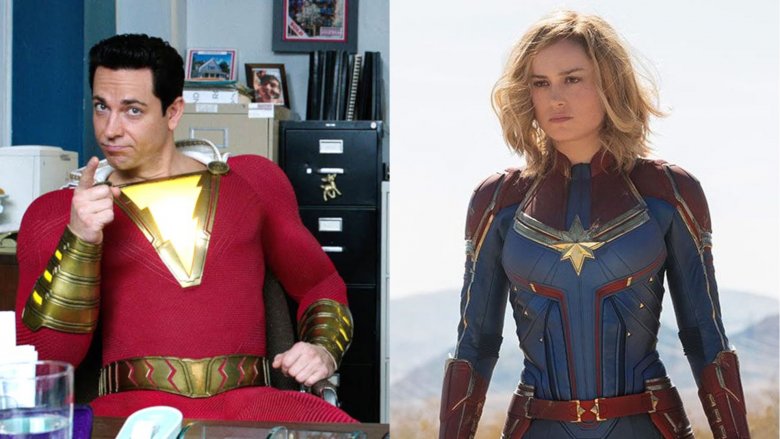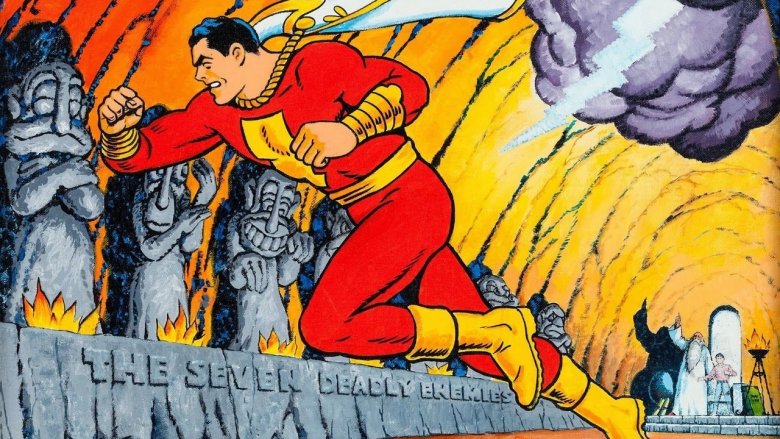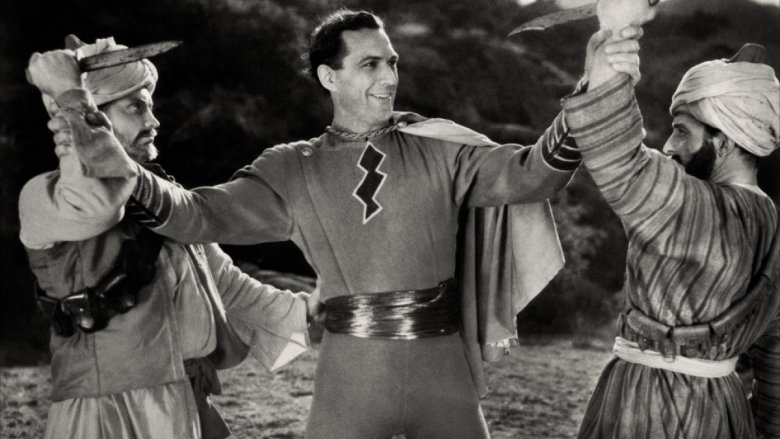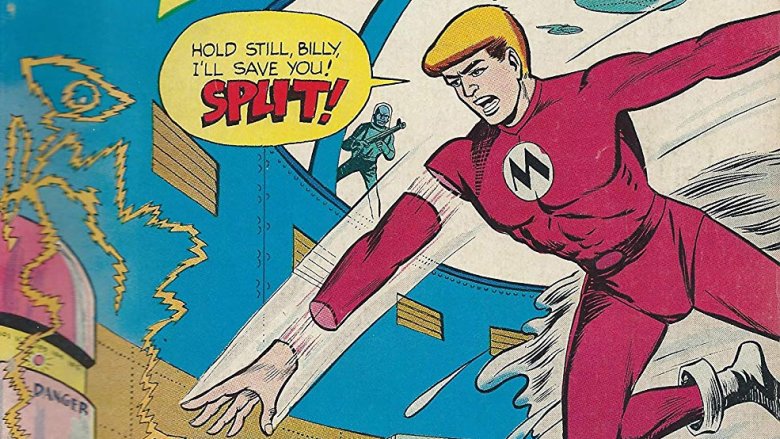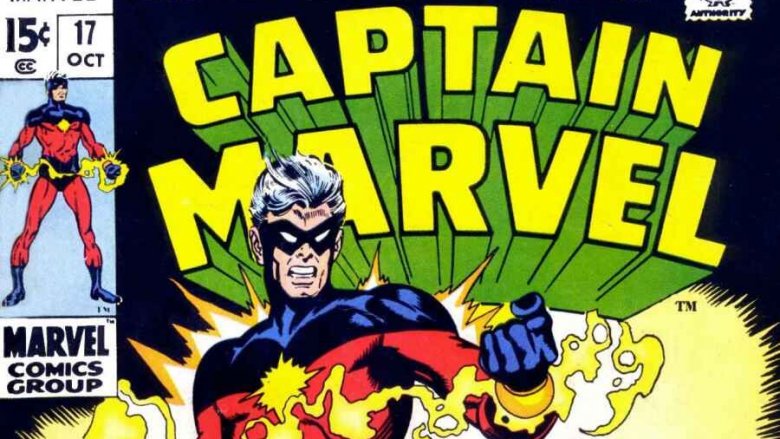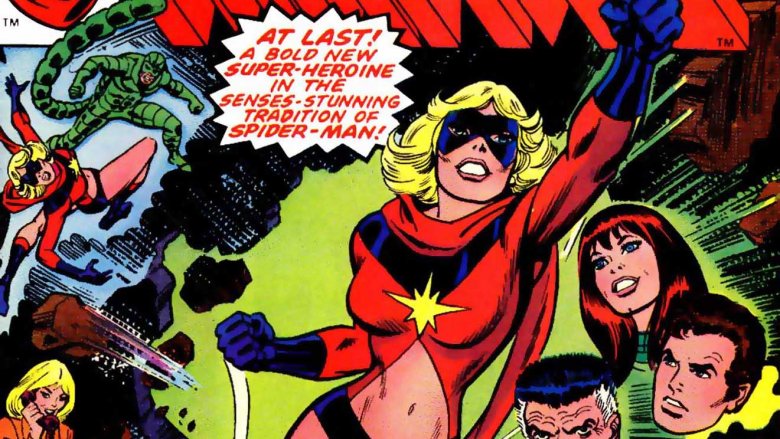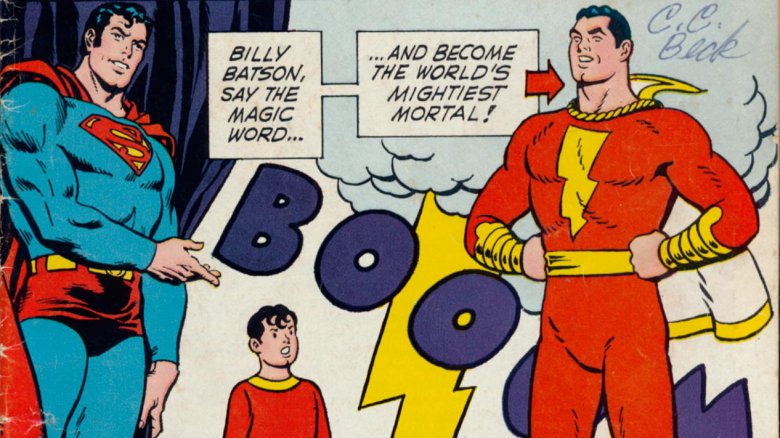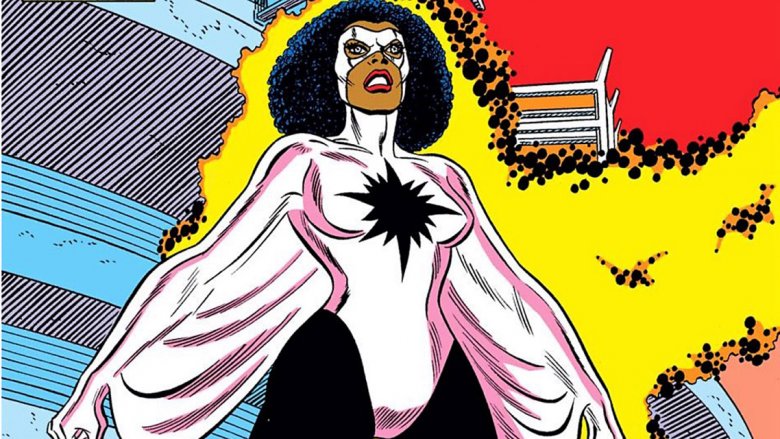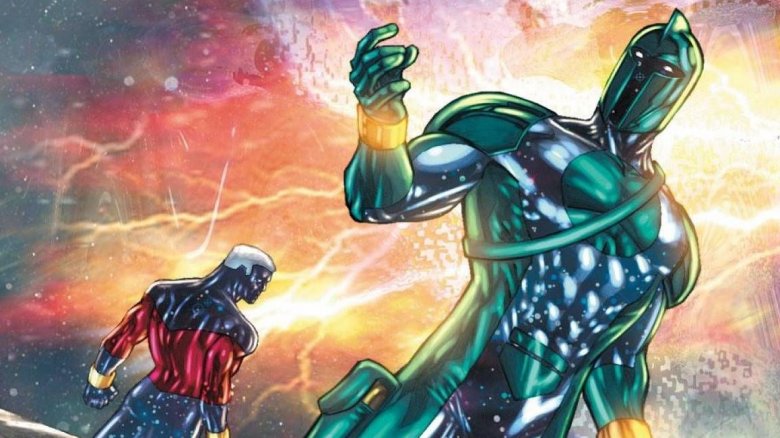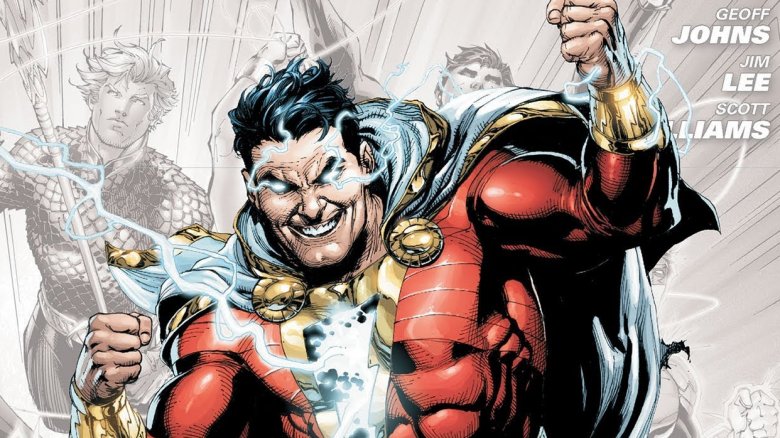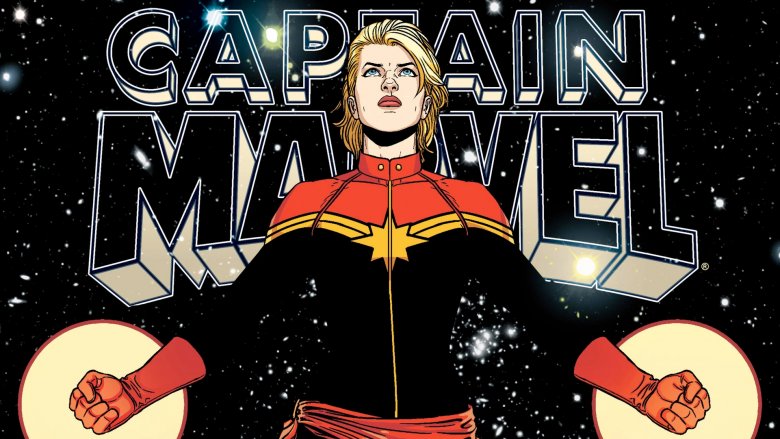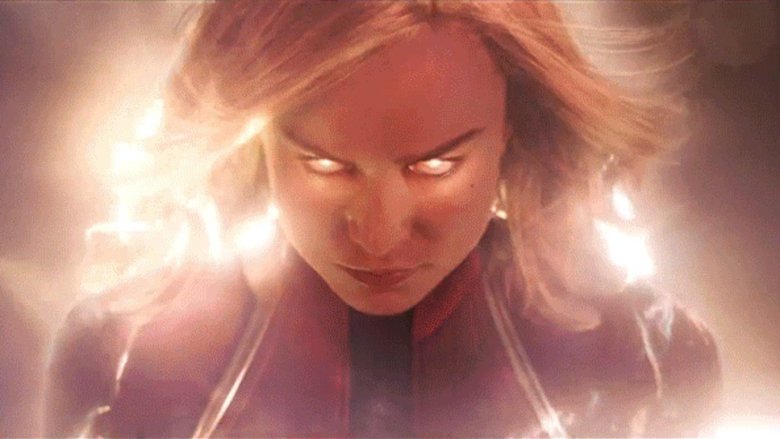The Connection Captain Marvel Has With Shazam!
Who is Captain Marvel? If you've seen the new Marvel Studios movie, you already know that she's an Air Force pilot turned interstellar warrior named Carol Danvers. Still, you might be wondering — wasn't there another Captain Marvel, a man in a red costume, who was a part of popular culture long before Carol Danvers used the name?
In fact, isn't that other Captain Marvel the star of DC's new movie, Shazam? The one where Billy Batson says the magic word that's also the title, and a flash of lightning turns him into a Superman type in a white cape?
It's understandable if you're confused. There have been many Captains Marvel over the years, and somehow in 2019, the original version and the current version are both in movie theaters. So, how did the same name move from a classic DC character to a very contemporary Marvel character? Let's try and figure that out, as we look at the strange history of the name "Captain Marvel."
The boy hero and the wizard Shazam
When C.C. Beck and Bill Parker created Captain Marvel for Fawcett Comics in 1939, the whole idea of the superhero was pretty new. Superman had only debuted in 1939, and most of the superheroes who followed were direct riffs on that basic concept. Captain Marvel, who debuted in Whiz Comics #2, aligns closely with the Superman template — black hair, square jaw, cape, strength, flight, and invulnerability — but he has a very unique origin that appealed to children like no other superhero could.
Billy Batson is a kid himself, and a hard luck orphan at that. He's chosen by the wizard Shazam to become a champion for justice. Whenever Billy says the wizard's name, he transforms into an adult superhero, who in the old days even had a different more mature personality. "Shazam" isn't just the wizard's name and Cap's magic word, it's also an acronym for the deities and mythical heroes who provide his powers. The wizard's magic imbues Captain Marvel with the Wisdom of Solomon, the Strength of Hercules, the Stamina of Atlas, the Power of Zeus, the Courage of Achilles, and the Speed of Mercury.
Captain Marvel vs. Superman
With Beck on art and writer Otto Binder on most of the stories, Captain Marvel became one of the most popular comic book characters of the 1940s. He was even the first superhero to appear on film, in the Republic cliffhanger serial The Adventures of Captain Marvel, which came out in theaters in 1941. In the comics, Captain Marvel gained a whole family of supporting characters, including a sister, Mary Marvel, and a teen sidekick, Captain Marvel Junior (who wasn't necessarily older than Billy Batson, but stayed the same age when he transformed).
There were a lot of superheroes who closely resembled Superman, but Captain Marvel was the only one who rivaled his inspiration in popularity, which may be why DC Comics sued Fawcett Comics for copyright infringement. The two companies were tied up in court for years, as superhero comics lost a lot of their popularity. When it became clear that DC was likely to win, Fawcett was ready to settle, and agreed in 1952 to cease publication of the character, whose heyday had come and gone by then anyway.
The forgotten Captain Marvel of 1966
In 1966, a small comics publisher called M.F. Enterprises realized that nobody was using the name "Captain Marvel" since Fawcett closed up shop, so they launched a new Captain Marvel #1, featuring a new hero created by veteran artist Carl Burgos. This Captain Marvel was an android who came to Earth from a dead planet. He had the power to divide his body into pieces by shouting the word "Split!" and called his body back together with the word "Xam!" His costume was a fuchsia body stocking, and his archenemy was the Bat, who also happened to resemble a certain DC Comics hero. This version of Captain Marvel even had a young ward named, of all things, Billy Baxton, which made it pretty clear from the get-go that originality was not the goal here.
However, while nobody else had a character named Captain Marvel, an increasingly popular publisher (which had previously used the names Timely and Atlas) had already changed their name to Marvel Comics, which didn't bode well for any other company publishing a book with the word "Marvel" in the title. Marvel sued over the name and reached a settlement, paving the way for their own Captain Marvel to debut.
The Marvel Captain Marvel, Mar-Vell
If Marvel wanted ownership of the "Captain Marvel" name, they needed a superhero to claim it. So, in 1967's Marvel Super-Heroes #12, Stan Lee and Gene Colan introduced a new character whose real name was Captain Mar-Vell. An alien from a human-like race called the Kree, Mar-Vell was sent to spy on Earth, but became its defender, with the humans he protected simplifying his name into Captain Marvel. Captain Marvel quickly got his own series, although his popularity was shaky enough that he was frequently revamped.
The original Lee/Colan version was simply an alien soldier who wore a green Kree uniform as his superhero costume. When Roy Thomas and Gil Kane revamped the character in Captain Marvel #17, he got a more superheroic red and blue costume, and as an homage to the original Fawcett character, he gained the ability to swap dimensional space with teenager Rick Jones whenever they clapped their matching bracelets together. In Captain Marvel #25, Jim Starlin revised Mar-Vell again, making him the official "Protector of the Universe" and giving him the power of Cosmic Awareness, which introduced Starlin's trademark psychedelia to the book. The book also gave us a villain you may have heard of — a Starlin creation called Thanos.
Despite all of these prestigious creators, Captain Marvel was never wildly popular, and after his book was canceled with issue #62, Marvel published a graphic novel by Jim Starlin called The Death of Captain Marvel, and yes, the title gives away the ending.
Carol Danvers and the Mar-Vell connection
Carol Danvers was originally a supporting character in the Mar-Vell stories, a United States Air Force officer in charge of security on the military base where Mar-Vell worked in his human disguise. In one story, she was injured when she and Mar-Vell were both caught in the explosion of a Kree device. In 1977's Ms. Marvel #1, it's revealed that the explosion infused Carol's body with Kree DNA, giving her similar powers to Captain Marvel's. Adopting a similar costume, she becomes Ms. Marvel, a deliberate attempt to create a superhero for the burgeoning feminist movement.
As Ms. Marvel, Carol would go on to join the Avengers, and later become an ally of the X-Men. After temporarily losing her memory and superpowers to Rogue, a villain who would go on to become a popular hero and X-Man, she took on the more powerful identity of Binary in Uncanny X-Men #164, and became a part of the Starjammers, a group of interstellar freedom fighters who would keep her away from Earth for much of the '80s and '90s.
The original returns, but his name's a problem
Meanwhile, the original Fawcett Captain Marvel was too popular, too fondly remembered, to stay gone forever. Fawcett had agreed never to publish the character again at DC's insistence, so DC, looking for new properties that could be lucrative, licensed the character and published him and his entire Marvel Family themselves starting in 1972. They kept all the characters original names, but called the comic itself Shazam! to avoid Marvel's copyright. They originally tried to give the book the subtitle "The Original Captain Marvel," but Marvel Comics sent them a cease and desist letter, so it was changed to "The World's Mightiest Mortal." In the book, though, he was still Captain Marvel, sharing space in the imagination of children with his counterpart Marvel.
Originally, the Marvel Family lived on their own Earth with their own continuity, only occasionally crossing the dimensional barrier to interact with Superman and the Justice League. When the DC Universe was streamlined with the Crisis on Infinite Earths crossover in the mid-1980s, Captain Marvel was rebooted as a part of the mainstream DC Universe, and even became a prominent member of the Justice League in the late 1980s.
A new Captain Marvel for the '80s
The death of Mar-Vell left Marvel Comics without a Captain Marvel of their own, but that changed in The Amazing Spider-Man Annual #16, when Roger Stern and John Romita Jr. introduced Monica Rambeau, a black woman from New Orleans who gained the power to transform her body into various kinds of energy. As the new Captain Marvel, Monica joined the Avengers, where she was a prominent member for the five years that Roger Stern wrote the book. She never had her own series, but she did get two one-shots, both by the impressive team of Dwayne McDuffie and Doc Bright.
After her time with the Avengers was over, Monica didn't manage to keep the Captain Marvel name for long, as Marvel Comics was clearly more interested in trying it out on new characters. Over the years, Monica has gone by Photon, Pulsar, Spectrum, and at times simply by her real name.
The lesser Captains Marvel of Marvel Comics
Mar-Vell's son, Genis-Vell was first introduced by Ron Marz and Ron Lim in 1993's Silver Surfer Annual #6, under the name Legacy. He went on to star as the title character in three consecutive Captain Marvel series, none of which were huge hits. Initially, his Captain Marvel look was similar to Mar-Vell's classic red and blue, except his face was entirely blue and his form was infused with stars. Later, he adopted a green and white outfit inspired by his father's original Kree uniform, but with a helmet that concealed his face, and keeping the star motif.
Issue #16 of the third Genis-Vell Captain Marvel series also introduced Genis-Vell's sister, Phyla-Vell, who wore a similar red and blue costume and used the name Captain Marvel herself for a while, although she's better known as a member of the Guardians of the Galaxy under the name Quasar, and has also gone by Martyr.
Another Captain Marvel in this era was the Skrull known as Khn'nr, who was initially introduced as a resurrected Mar-Vell, before he was revealed as a Skrull sleeper agent during the Secret Invasion crossover. Like Mar-Vell before him, Khn'nr chose to fight for humanity against his own people, but he was ultimately killed.
Noh-Varr, the extradimensional Kree teen originally known as Marvel Boy, briefly became Captain Marvel as part of the Dark Reign crossover, but the name never stuck. By 2011, the only prominent Captain Marvel in comics was the original version at DC, but that would soon change.
A Captain no more
In 2011, DC Comics made the unprecedented move of rebooting their comic book universe from the ground up, and relaunching their entire line of books with new #1 issues. When the World's Mightiest Mortal was rebooted for the new continuity by Geoff Johns and Gary Frank in 2012, it was the perfect opportunity to finally take care of a lingering problem. Captain Marvel wasn't the superstar he'd once been, but he was still a hero that bore the name of DC's biggest rival — a name DC wasn't even legally allowed to put on the covers of his comics.
So when Billy Batson and his big red alter ego were reintroduced in a backup story in Justice League #7, the character who'd previously been Captain Marvel was now called Shazam, with the wizard who gave him the name being referred to simply as "the Wizard." While readers were resistant to the change, writer Geoff Johns defended it, saying, "Well, there are a lot of reasons for the change. One is that everybody thinks he's called Shazam already, outside of comics."
Whatever DC's motivation, the most popular character ever to be named Captain Marvel had given up the moniker, creating an opening for Marvel to bestow the title on someone who wouldn't have to share it, and who could redefine the name and own it in a way that all their previous characters — including Mar-Vell — had failed to do.
A new classic Captain Marvel for a new era
In 2012, Marvel launched a new Captain Marvel book by Kelly Sue DeConnick and Dexter Soy, starring a familiar face. Carol Danvers, the original Ms. Marvel, finally took up the mantle of the man who gave her superpowers in the first place: Mar-Vell. She also got a very stylish new costume designed by Jamie McKelvie, which resembles Mar-Vell's classic red and blue outfit, but with the colors reversed and more militaristic detailing.
The new Captain Marvel emphasizes Carol's military background, her passion for flight, and her friendships with other women. If her first Ms. Marvel book was a questionable attempt at cashing in on Second Wave Feminism, her new incarnation was a hit with the Third Wave, attracted a devoted (and mostly female) following who became known as the Carol Corps. It's hard to imagine Carol Danvers as Ms. Marvel making her way to the MCU, but once she became Captain Marvel — and the publisher's flagship female hero — her cinematic debut began to feel inevitable.
And that's how we got here
The only surprising thing about Captain Marvel being the first female-fronted Marvel movie is that nobody got there before her. A Black Widow movie seemed like an obvious move, but it's one Marvel hasn't made (yet). Still, better late than never, and Carol Danvers is a great character to introduce in a position of such prominence. For anyone who questioned her potential, the box office makes a fine refutation.
Even as the current Captain Marvel finds cinematic success, however, the original version still waits his turn. The character played by Zachary Levi in Shazam may not be named Captain Marvel, but he still shares a part of that legacy, a legacy that he in fact originated almost 80 years ago.
Aside from falling within the superhero genre, the two movies couldn't seem more different in tone, plot, or character. What unites them is history, and the convoluted story of the most contested comic book character name of all time.
